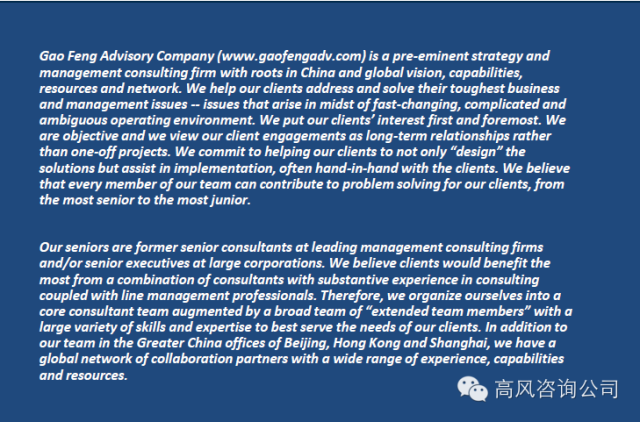
After over 20 years of investment in China, some multinational companies (MNCs) have demonstrated successes whilst others like Home Depot, Best Buy, Media Markt, and Mattel have either significantly scaled down their China operations or have chosen to withdraw from the market. For the successful ones, China is now one of their most important, if not the most important market in the world. To many of them, the outlook of their China business continues to be strong and they plan to continue to invest significantly in this market. Prime examples of these are the automakers especially those in the premium segment, as well as companies like Apple, Yum! Brands, Starbucks and Honeywell.
So, what lies behind the performance difference? Clearly, the industry makes a difference. In China, there are broadly three different types of market access from the standpoint of foreign companies. First, there are sectors which are closed or largely closed to foreign participation such as telecom operations, (much of) oil & gas, military and defense, etc. Second are sectors that are completely open. Foreign companies, as well as Chinese ones, are allowed to participate. Often, these sectors are very competitive. MNCs find not only their usual MNC competitors in these sectors but also, in many cases, Chinese competitors, some state-owned and some private. MNCs need to bring their best-in-class capabilities to bear in order to be successful. Examples of these are consumer goods, retail, automotive parts, etc. In between these two sectors is the third type, the partially open industries.
They are neither completely open nor closed. A case in point is the automotive manufacturing sector where the Chinese government dictates any foreign auto OEM must form a joint venture with a local auto OEM, with a maximum foreign share of 50%. As such, the structure, conduct and performance of any industry sector depends on where that industry fits within the regulation context. And, as China continues its liberalization process, this context is also evolving. So in short, one cannot and should not generalize the patterns of doing business in China based on isolated data points, especially ones that are outdated.
However, in every sector that MNCs are allowed to operate, some companies are better performers than others. For instance, in the premium car sector, the major German auto makers are doing quite well while the Japanese ones are almost nowhere to be seen. For KFC, over half of global revenues and profits now come from China, but their key global competitor McDonald’s is way behind in its China presence. In fact, in these days of data abundance and transparency, almost every company can see the same set of China market data, and yet we see completely different strategies generating completely different results.
In addition to strict industry and functional knowledge, a deep understanding of the China context is an essential component for MNCs to become successful in China. Unfortunately and surprisingly, this has largely been ignored by many MNCs. Too many companies believe that they have figured out their own business and are able to operate their business in more or less the same way in (many parts of) the world. They expect China to follow the same or more or less similar patterns, and therefore they tend to “cut and paste” their strategy or business model. Sometimes this work but often times, it doesn’t. Not only is China large and fast growing, it is also complex with a range of leapfrogging and time-space compressed phenomena taking place at the same time. Overlaid on top of all this is China’s historical, political and social context that makes the overall conditions quite unique and most likely somewhat different to the MNCs other markets.
In my view, the key to success for MNCs in China is first and foremost the companies’ local leadership. The local leadership must understand and internalize the China context as mentioned above. It also needs to be stable enough to build and instill the critical institutional knowledge for doing business in China, a valuable asset for any MNC. The degree of alignment between the China realities and the expectations of the global headquarter (CEO) often dictate whether an MNC can succeed in China or not. Often the global expectations can be overly optimistic or overly pessimistic over a very short time horizon, making decisions on China erratic.
Based on all of the above, making China work will require the MNCs to carefully adapt their global operating model to China. Many MNCs have developed clear and strong global functional capabilities and they tend to apply these capabilities all over the world without customization. However, the realities in China force many MNCs to rigorously examine what parts of the global operating model can be leveraged for China, and what part cannot – and by implications will need to be developed in China for China. This can be a contentious process as global functions are often very proud of their achievements and status and fundamentally believe the world should follow the same standards and processes. If local acquisitions are involved, then the Chinese operators would tend to argue that China is (somewhat) different. The balance between the two requires deep understanding and reflection on changes in processes, decision rights, KPIs, etc. and importantly the mindset and culture. Getting this right, however, is often what defines whether an MNC can be successful in China, or not.
MNCs should ask themselves whether their China business should be part of the foundations of their entire business – is it possible, for example, to use capabilities developed in China not only to succeed in China but to enhance their performance globally? Indeed, could they plausibly apply advantages acquired in China to their global operations in a way that would result in China becoming the core and integral part of their global strategy instead of a fringe presence?
Of course, the answer isn’t always “yes” (though it could be “not yet”). As mentioned before, the China market brings a number of peculiar characteristics and as a result, the demand pattern in any sector in China can be much more complicated and far-ranging that any markets in the rest of the world. Often companies find that they need to use a much larger number of product market segments to fully characterize the China market than other markets in the world. In addition, boundaries of industries are often being re-defined due to emergence of a range of enablers, among which the prevalence of the wireless internet is probably the most influential.
The combination of a complicated and quickly changing demand pattern, hyper intensive competition (in open sectors), fluidity in industry boundaries, and discontinuities in the regulatory context all require companies, both foreign and Chinese, to continuously develop new sources of competitive advantages in order to secure a better position in the market. These new sources of competitive advantages can manifest in various ways – newer products, brands, ways to go to market, service models or even the entire business models, as well as “intangible” capabilities such as speed, agility and flexibility.
MNCs will find themselves compelled to integrate the advantages that China-based operations have into their global value chains – research and developing products there, selling into its markets, and then using the economies of scale China allows to take those goods to the rest of the world. In many arenas, China either is already or has the potential for being the world’s leading breeding ground for business innovations. Mentally, MNCs should not view China merely as a marginal or fringe market. Instead they should put China right at the core and as an integral part of their global strategies.
Without the proper position, the China business would not be given the proper priority or resources to support its growth. Not only this would place China at the right priority of the companies’ global business, it would also enable the companies to adjust their global organization that gives the China operations the right levels of decision rights, agility flexibility and resilience. After all, it is a shift in (or adoption of) corporate mindset and culture that cater for the centrality of China in companies’ global business.
China is going through a real transformation. As a whole, it is already the world’s largest or second largest economy. On a per-capita basis, it is going from a relatively low income country into one that is considered “middle class”, within the next decade or so. The government is undertaking a large number of reforms covering social, economic and other areas — and eventually political Reform of the state-owned enterprises is already underway. The rapid rise of the private sector is more evident than any time before. Entrepreneurship is thriving in China. This transformation will bring both tremendous challenges but also opportunities to all types of businesses, MNCs included. They key is whether one can see through the veil and identify the real opportunities and prepare for capturing them before they arise, while have a sensible way to manage the risks. MNCs should not be distracted by short-term events that may have some news worthiness, but should focus on thinking through the China context and draw implications for their China strategy on a medium and longer term.


